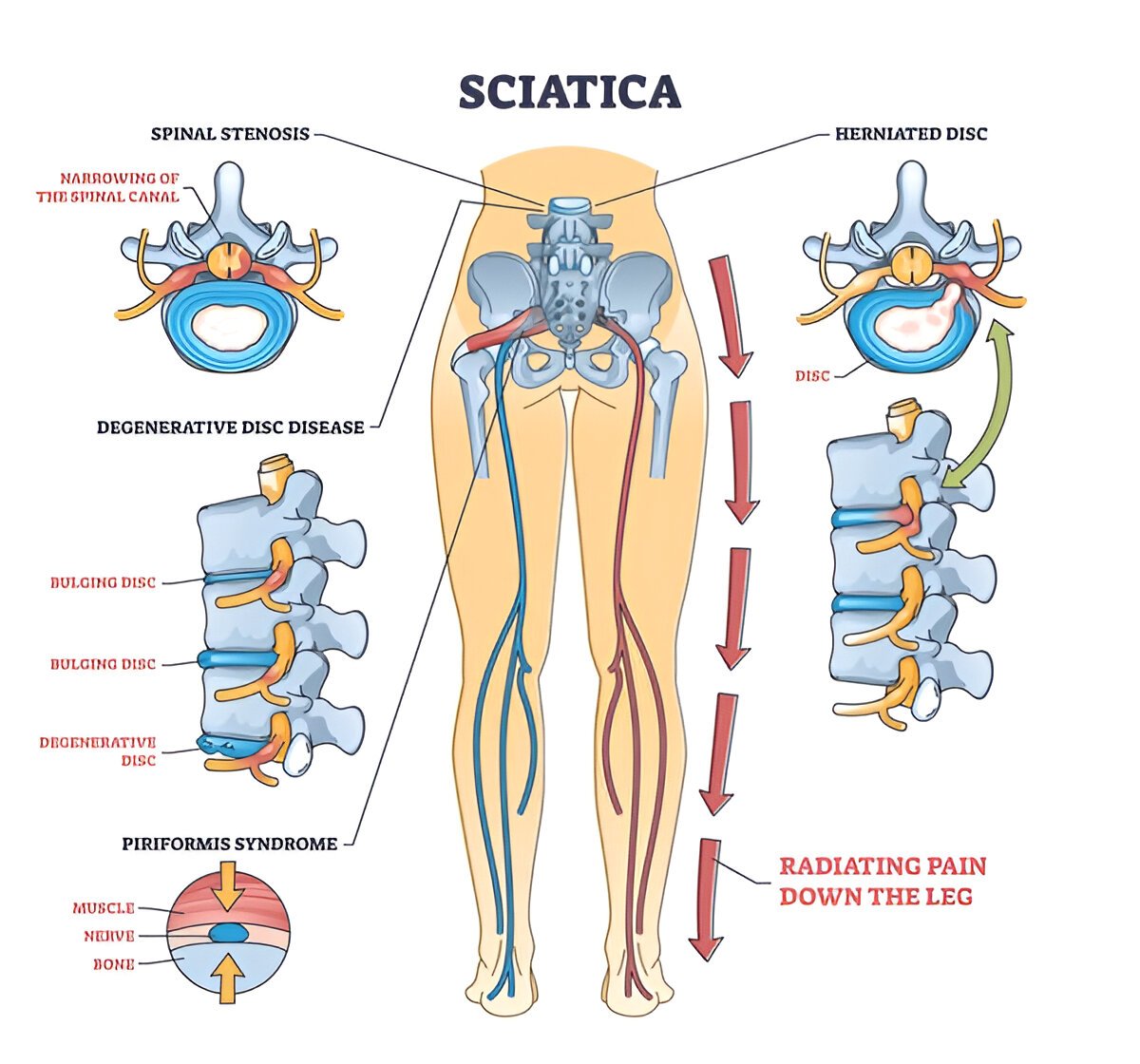Sciatica
Finding Relief from Nerve Pain
Ever felt a sharp, intense pain rush down from your lower back to your leg? Well, you’re not alone if you’ve already experienced firsthand how severe sciatica can be. Simple things that used to be no big deal, like sitting at your desk, getting out of bed, or taking a short walk, all of a sudden turn into an unbearable slog. At Rapid Physiocare, our team of expert physiotherapists get it. We know just how nerve pain can put a wrench in your daily routine and sap your confidence. Our goal is to get you moving freely again without the fear of discomfort or pain holding you back.

What is Sciatica?
Sciatica isn’t a condition in itself; it’s more of a sign that something’s nipping away at your sciatic nerve, the longest nerve in the body. That nerve runs from the lower back down through the buttocks to each leg, and when it gets squished, often by a herniated disc, bone spur, or some muscle tightness, all sorts of pain, tingling, or numbness can start to kick in. This can range from a dull ache in the lower back and glutes to sharp, electric-like pain all the way down one side of your body, including in your calf or foot.
The good news is that in most cases, sciatica can be treated without surgery. We use a combination of targeted physiotherapy and movement rehab to get you back on track.
Common Sciatica Symptoms
It turns out that sciatica can manifest in loads of different ways. Some people get a mild ache in the lower back and glutes, while others experience sharp, electric-like pain all the way down one side of their body. You might notice:
- That shooting pain from the lower back to the thigh or calf
- Numbness or tingling in the leg or foot
- Muscle weakness or heaviness in one leg that’s making everyday activities tough
- Difficulty standing up or walking for long periods without wincing in pain
- Pain that gets worse when you cough, sneeze, or sit in one place for too long
If any of these sound like something you’ve been dealing with, don’t worry you’re certainly not alone. At Rapid Physiocare, we see loads of working professionals in Singapore who’ve developed nerve compression from sitting at a desk all day, their posture being a bit off, or their muscles just plain tight.
What Causes Sciatica?
The most common causes of sciatica are:
- Herniated or slipped disc pressing on the nerve roots
- Degenerative disc disease or bone spurs narrowing the spinal canal
- Muscle tightness, especially in the piriformis (deep buttock muscle)
- Poor posture or prolonged sitting
- Sudden lifting injuries or awkward bending movements
Some people also experience left side lower back pain or lower leg discomfort due to uneven pressure or movement patterns. Our physiotherapists will assess the root cause, not just the pain surface.
How Physiotherapy Helps Relieve Sciatica Pain
At Rapid Physiocare, we use evidence-based physiotherapy techniques to reduce nerve irritation, restore movement and prevent recurrence. Your program is tailored to your pain level, lifestyle and physical goals.

1. Pain Relief and Inflammation Control
In the early phase, we focus on sciatic nerve pain and inflammation.
We use:
- Gentle manual therapy and myofascial release
- Electrotherapy and ultrasound to calm irritated tissues
- Heat or cold therapy to relieve muscle tension
2. Restoring Movement and Flexibility
Once the pain eases, we guide you through safe, targeted exercises to stretch and strengthen key muscle groups especially your core, glutes and hamstrings. These muscles support your spine and reduce pressure on the sciatic nerve.
Your physiotherapist will also teach you the best sitting position for sciatica, posture corrections for your work setup, and mobility drills to keep your lower back stable.
3. Strength and Long-Term Prevention
As your mobility returns, we focus on building long term resilience. You’ll work on exercises for sciatica pain relief and nerve mobility, learning how to move correctly during daily tasks. This prevents flare-ups and gets you back to your normal routine, whether that’s running, driving or sitting through meetings without pain.
Home Care Tips for Managing Sciatica Pain
While professional physiotherapy accelerates recovery, a few lifestyle changes can make a big difference:
- Don’t sit for long periods; stand or stretch every 30 minutes. Do sciatica exercises like knee to chest stretches or pelvic tilts.
- Use ergonomic chairs or lumbar support at your desk.
- Stay active; walking and swimming help with flexibility.
Remember, “no pain, no gain” can make nerve irritation worse. Always check with your physiotherapist before trying new exercises or stretches.
What to Expect at Rapid Physiocare
When you come to our clinic, your session starts with a full assessment by a physiotherapist. We’ll look at your posture, strength, flexibility and lifestyle habits to find out what’s irritating your sciatic nerve.
From there we’ll build a personalized care plan, often combining manual therapy, exercise prescription and education to empower you in your recovery. Every session is hands-on, progress driven and designed to help you understand what your body needs to heal.
Our team will also guide you on how long recovery will take. Most patients see improvement in a few sessions, but chronic or severe cases may take several weeks. We track progress closely and adjust the treatment as your pain decreases and function improves.
Why Choose Rapid Physiocare?
- Experienced therapists: Advanced training in musculoskeletal and nerve rehabilitation
- Multiple clinic locations: Across Singapore for your convenience
- Patient-first approach: We listen, assess and treat the root cause
- Evidence-based practice: Combines science with compassion
- Collaborative care: We work with doctors and orthopedic specialists when needed
Our mission is simple: To help you move better, feel better and get back to doing what you love without pain holding you back.
Book Your Appointment Today
If sciatica pain is affecting your sleep, work or daily comfort, don’t wait for it to get worse. With early physiotherapy and the right movement strategy, full recovery is possible.
Book an appointment with Rapid Physiocare today and take the first step towards sciatic nerve pain relief. Our team is ready to help you regain your strength, comfort and confidence one session at a time.
Frequently Asked Questions
How long does it take for sciatica to go away?
Recovery time depends on what’s causing the nerve irritation and how early treatment begins. For most mild cases, sciatica pain can ease within 4–6 weeks with proper physiotherapy and home care. Chronic or severe cases may take a few months if there’s a disc injury or long-term muscle tightness involved. The key is early assessment – The sooner we release the pressure on the sciatic nerve, the faster your recovery. Avoid waiting for it to “go away on its own,” as pain can become harder to treat later.
Is walking good for sciatica?
Yes, gentle walking is often one of the best activities for sciatica recovery. It keeps blood flowing to the affected nerve and prevents your lower back from stiffening up. Start slow: short walks on even ground, maintaining upright posture and relaxed steps. If walking increases your leg pain or numbness, stop and rest. A physiotherapist can guide you on walking posture, stride length, and simple stretches to do before and after to avoid flare-ups.
What sleeping position helps relieve sciatica pain the most?
The goal is to reduce pressure on the lower back and sciatic nerve. Most people feel relief sleeping on their side with a pillow between their knees to keep the spine aligned. If you prefer sleeping on your back, place a pillow under your knees to ease tension on the lower spine. Avoid sleeping on your stomach, it can twist your back and worsen nerve pain. Using a medium-firm mattress and maintaining good posture when getting out of bed also helps reduce morning stiffness.
What triggers your sciatica?
Common triggers include prolonged sitting, poor posture, lifting heavy objects with a rounded back, or sudden twisting movements. Tight muscles in the buttocks (especially the piriformis) can also compress the nerve. Even stress can increase muscle tension and make pain flare up. Small habits like sitting cross-legged, slouching over a laptop, or driving long hours can silently aggravate symptoms. Understanding your triggers is the first step; your physiotherapist will teach you movement patterns and stretches to keep the nerve calm.
What is the fastest way to heal sciatica?
There’s no instant fix, but the fastest and safest recovery happens when you address the root cause, not just the pain. A physiotherapist-guided program combining manual therapy, posture correction, and targeted strengthening exercises brings quicker results than rest alone. Avoid “quick relief” promises like aggressive stretching or long periods of bed rest as both can worsen nerve compression. Consistency with your prescribed exercises, posture care, and lifestyle changes delivers faster and lasting relief.
Can massage help sciatica?
Yes, but it depends on the type of massage and what’s causing your pain. Gentle myofascial release or deep-tissue techniques by a trained physiotherapist can relax tight muscles around the lower back and glutes, easing pressure on the sciatic nerve. However, random or overly strong massages can irritate the nerve further. Always get your condition assessed first to determine the right kind of manual therapy, combined with stretching and strengthening offers far better results than massage alone.
Is heat or ice better for sciatica?
It depends on your symptoms.
- Ice is best in the early stage (first 48–72 hours) or after a flare-up to reduce inflammation and numb sharp pain.
- Heat helps when muscles feel tight or stiff, as it improves blood flow and promotes relaxation.
Many patients benefit from alternating between the two: Start with ice to calm pain, then switch to gentle heat after a few days. Your physiotherapist can advise on the right timing and duration based on your recovery phase.

